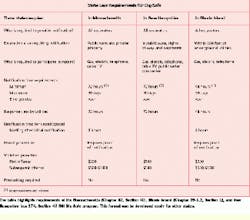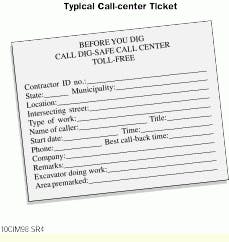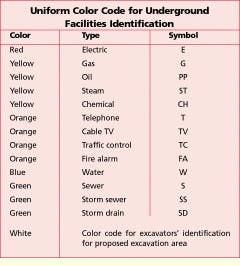Call before you dig-- or pay the penalty
When it comes to excavating, what you don`t know can hurt you.
Anthony Minichiello,
In 1998, the federal government appropriated several billions of dollars for road construction, bridge work, and municipal sewer and water projects. This massive outlay has created dust, commuting delays, overheated engines, and utility-services interruption--often caused by "dig-ups" of buried telecommunications facilities by contractor backhoes and others.
The Federal Communications Commission requires that all local and long-distance competitive access providers and telecommunications organizations file reports of a "major service outage," defined as an outage during which 30,000 patrons lack service for more than 30 minutes.
According to these reports, approximately 50% of these outages are due to contractor dig-ups. Frequently, the excavator failed to notify the underground-facility owner of the incident or did not provide sufficient advance notice of the excavation.
Both federal and state laws require that excavators notify the respective utility companies before undertaking any operation involving digging, trenching, blasting, demolishing, boring, backfilling, grading, landscaping, or any other earth-moving operation. Notifying each utility individually is time-consuming; however, calling Dig-Safe simplifies the process. Dig-Safe is the underground-facility damage-prevention program of a non-profit organization of the same name. When excavators notify Dig-Safe of their intent to dig, the organization notifies all concerned utilities with one call. Funded by member utility companies, Dig-Safe offers statewide, toll-free numbers. (The name "Dig-Safe" is not universal throughout the United States; some states use other designations.) For states where the program goes by another name, contractors can call the toll-free number listed on their utility bills or in their local telephone directory for further information about a Dig-Safe-type organization.
Federal regulations require that each state adopt a one-call damage-prevention program as a condition to receiving full funding for its pipeline safety-compliance program. The purpose of this requirement is to reduce the incidence of excavation damage to gas and hazardous-liquid pipelines and other underground facilities.
Approximately 90% of the states and the District of Columbia have laws to protect underground facilities from damage by excavation activities. Although these laws are not uniform, they most often require contractors to provide operators of underground facilities advance notice of the proposed excavation. Provisions of state laws include
- essentials of excavation activities
- detail of underground facilities
- notification and response times
- accuracy of marking
- color code for identification marking
- protection of underground facilities
- emergency procedures
- exemptions
- excavation permits
- penalties for violation
Penalties for violation of state damage-prevention laws range from $500 to $50,000, depending on the state.
One-call systems
One-call systems were initiated in response to increased damage to in-ground facilities during the building boom of the 1950s, 1960s, and early 1970s, when the intent was to go in-ground with utilities. Thousands of miles of in-ground facilities were exposed to damage by excavating machines, which interrupted utility services and threatened life, health, and property.
The current one-call notification system provides a communications link between the excavators and the owners and operators of underground facilities. A contractor planning an excavation notifies the local or statewide one-call center of the location and other details of the proposed work. This call must be made at least two days in advance. The one-call center notifies all utility owners with in-ground facilities in the area of the proposed excavation. A crew then visits the site and identifies and marks the location of in-ground facilities at the excavation site.
The American Public Works Association (Kansas City, MO) has established the minimum requirements for an efficient, one-call notification system:
One telephone number should be established for excavators to notify the one-call center, which, in turn, calls participating utilities within a predetermined area of coverage.
- The service should be provided during normal working hours, Monday through Friday.
- Off-hour calls should at least reach a recording, which explains emergency procedures.
- All telephone calls should be voice-recorded mechanically.
- The system should identify for the caller those utilities that will be notified of the excavation activity.
- The system should provide a permanent file number for each request.
- The system should provide, for a statutory period, a printed copy of all location requests, which can be retrieved easily through use of the file number.
- The system should provide a timely method of notifying the affected utilities. This method is to be determined by each system.
-The system primarily should service planned excavation activity. It may handle in-progress and emergency work, but it should always stress to its users the need for advance notification of excavation work.
- The system should provide periodic administrative reports as required by the participating utilities.
- The system should provide and document excavator education programs on an ongoing basis, document association contact, and otherwise be involved in a public relations campaign to broaden awareness of the need to call before digging.
The call to the one-call center can be initiated by anyone but is usually made by contractors working around utility facilities. This notification may be required so that the contractor can obtain the necessary permit from the regulating agency. The call is made for all digs around utility facilities and in any highway or street right-of-way, or when working under or around overhead facilities. Each center has its own unique operating procedures that reflect the local characteristics and legislative requirements of the area.
When the call center receives a call, the operator on duty usually completes a computer-generated location request form that identifies pertinent call-back information about the caller and the location of the work. In some cases, such as in urban or suburban areas, this process is simple. The caller provides a street address, road name, or intersection at which the excavation is being performed. It is more time-consuming to obtain information about rural sites because of the remoteness of the location or lack of reliable geographic references.
After establishing the job-site location, the call-center operator generally informs the caller which utility companies are affected. The call-center computer then assigns a unique ticket number to the location request for reference, tracking, and accountability.
Users of one-call notification systems include private firms, municipalities, utility companies, and anyone who needs to excavate or work with the soil in a way that could cause damage to subsurface structures. State damage-prevention laws identify the types of activities that require notification and how much advance notice is required. Users of one-call systems include operators of underground facilities such as:
- communications carriers for telephone and cable TV and other signal system operators
- electricity providers for transmission and distribution, private systems, cooperatives, municipal service, traffic control, and street lighting
- gas and petroleum product carriers
- water and sewer suppliers, both public and private
- transportation services, including railroad, rapid transit, shuttles, and roadways
- others that own or maintain substructures
One-call systems accept calls from anyone who needs to determine the location of in-ground facilities due to impending excavation. Most one-call centers use toll-free telephone numbers.
Field location and marking
After the one-call center has been notified, locating crews are dispatched to the job site to locate and mark the in-ground facilities. The crews may be dispatched from each of the utilities in the affected area, or a single contractor may provide this service for all utilities.
Once the facilities have been located, color-coded surface marks such as spray paint are placed over every buried facility to indicate the location, change in direction, and dead ends of buried lines. To increase visibility, color-coded vertical markers such as temporary stakes or flags are used to supplement the surface marks. All surface marks should indicate the name, initials, or logo of the company that owns or operates the line.
Guidelines for marking underground facilities have been developed by the Utility Location and Coordination Council of the American Public Works Association. These guidelines use a uniform color code to identify the type of underground facility. The code identifies a color to be used for each group of utilities of similar characteristics. Additional descriptions may be provided by letters and arrows to indicate the specific utility, its location, and function.
Before calling Dig-Safe, contractors should be prepared to provide the information shown in the ticket.
Anthony Minichiello is principal at Maximis Communications Consultants (Concord, NH).



